RENAULT TWINGO RS 2009 2.G Electrical Equipment - Petrol Injection Workshop Manual
Manufacturer: RENAULT, Model Year: 2009, Model line: TWINGO RS, Model: RENAULT TWINGO RS 2009 2.GPages: 348
Page 151 of 348
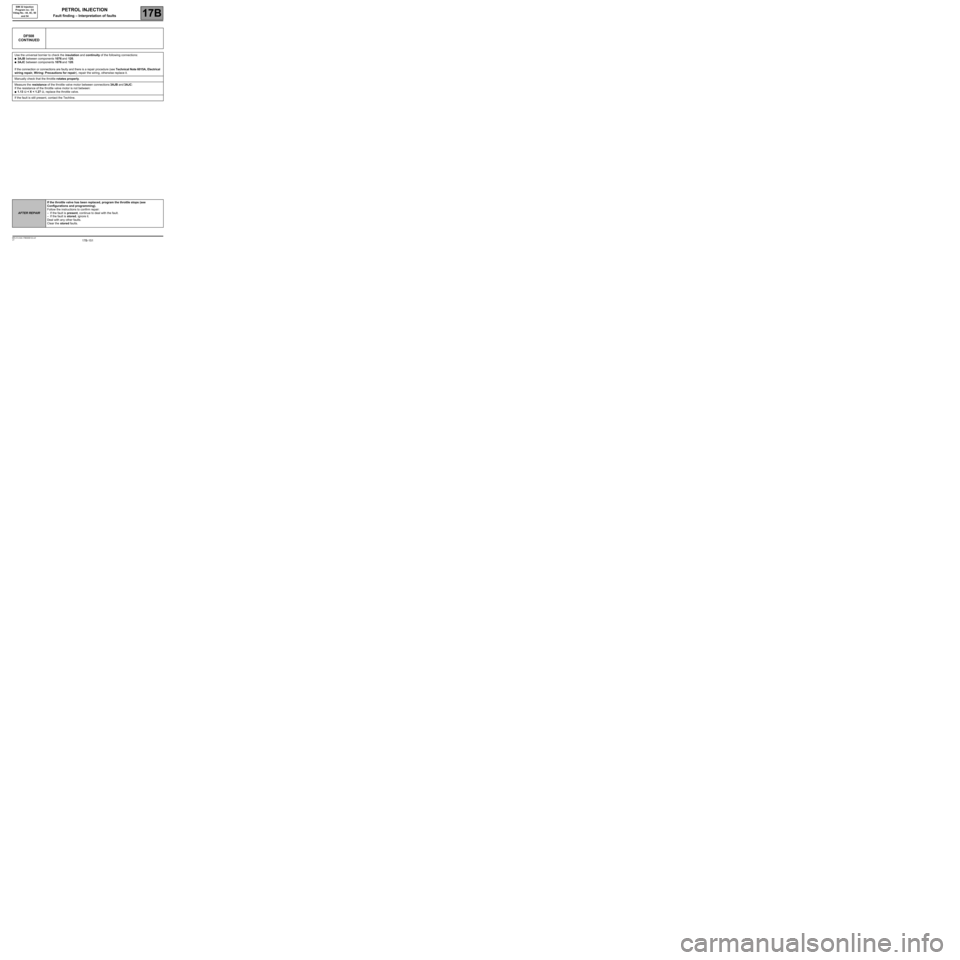
17B-151V7 MR-413-X44-17B000$133.mif
PETROL INJECTION
Fault finding – Interpretation of faults17B
SIM 32 Injection
Program no.: D3
Vdiag No.: 44, 4C, 50
and 54
DF508
CONTINUED
Use the universal bornier to check the insulation and continuity of the following connections:
●3AJB between components 1076 and 120,
●3AJC between components 1076 and 120.
If the connection or connections are faulty and there is a repair procedure (see Technical Note 6015A, Electrical
wiring repair, Wiring: Precautions for repair), repair the wiring, otherwise replace it.
Manually check that the throttle rotates properly.
Measure the resistance of the throttle valve motor between connections 3AJB and 3AJC:
If the resistance of the throttle valve motor is not between:
●1.13 Ω < X < 1.27 Ω, replace the throttle valve.
If the fault is still present, contact the Techline.
AFTER REPAIRIf the throttle valve has been replaced, program the throttle stops (see
Configurations and programming).
Follow the instructions to confirm repair:
–If the fault is present, continue to deal with the fault.
–If the fault is stored, ignore it.
Deal with any other faults.
Clear the stored faults.
Page 152 of 348
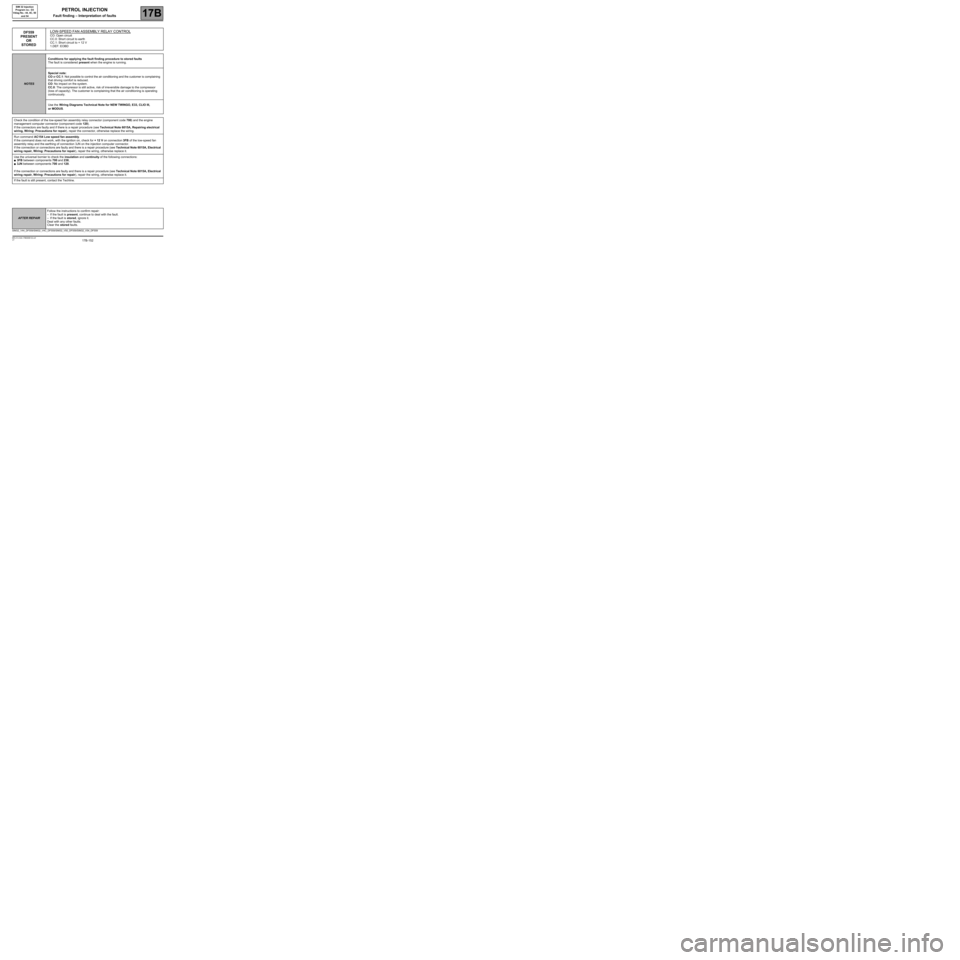
17B-152V7 MR-413-X44-17B000$133.mif
PETROL INJECTION
Fault finding – Interpretation of faults17B
SIM 32 Injection
Program no.: D3
Vdiag No.: 44, 4C, 50
and 54
DF559
PRESENT
OR
STOREDLOW-SPEED FAN ASSEMBLY RELAY CONTROLCO: Open circuit
CC.0: Short circuit to earth
CC.1: Short circuit to + 12 V
1.DEF: EOBD
NOTESConditions for applying the fault finding procedure to stored faults
The fault is considered present when the engine is running.
Special note:
CO or CC.1: Not possible to control the air conditioning and the customer is complaining
that driving comfort is reduced.
CO: No impact on the system.
CC.0: The compressor is still active, risk of irreversible damage to the compressor
(loss of capacity). The customer is complaining that the air conditioning is operating
continuously.
Use the Wiring Diagrams Technical Note for NEW TWINGO, E33, CLIO III,
or MODUS.
Check the condition of the low-speed fan assembly relay connector (component code 700) and the engine
management computer connector (component code 120).
If the connectors are faulty and if there is a repair procedure (see Technical Note 6015A, Repairing electrical
wiring, Wiring: Precautions for repair), repair the connector, otherwise replace the wiring.
Run command AC154 Low speed fan assembly.
If the command does not work, with the ignition on, check for + 12 V on connection 3FB of the low-speed fan
assembly relay and the earthing of connection 3JN on the injection computer connector.
If the connection or connections are faulty and there is a repair procedure (see Technical Note 6015A, Electrical
wiring repair, Wiring: Precautions for repair), repair the wiring, otherwise replace it.
Use the universal bornier to check the insulation and continuity of the following connections:
●3FB between components 700 and 238,
●3JN between components 700 and 120.
If the connection or connections are faulty and there is a repair procedure (see Technical Note 6015A, Electrical
wiring repair, Wiring: Precautions for repair), repair the wiring, otherwise replace it.
If the fault is still present, contact the Techline.
SIM32_V44_DF559/SIM32_V4C_DF559/SIM32_V50_DF559/SIM32_V54_DF559
AFTER REPAIRFollow the instructions to confirm repair:
–If the fault is present, continue to deal with the fault.
–If the fault is stored, ignore it.
Deal with any other faults.
Clear the stored faults.
Page 153 of 348
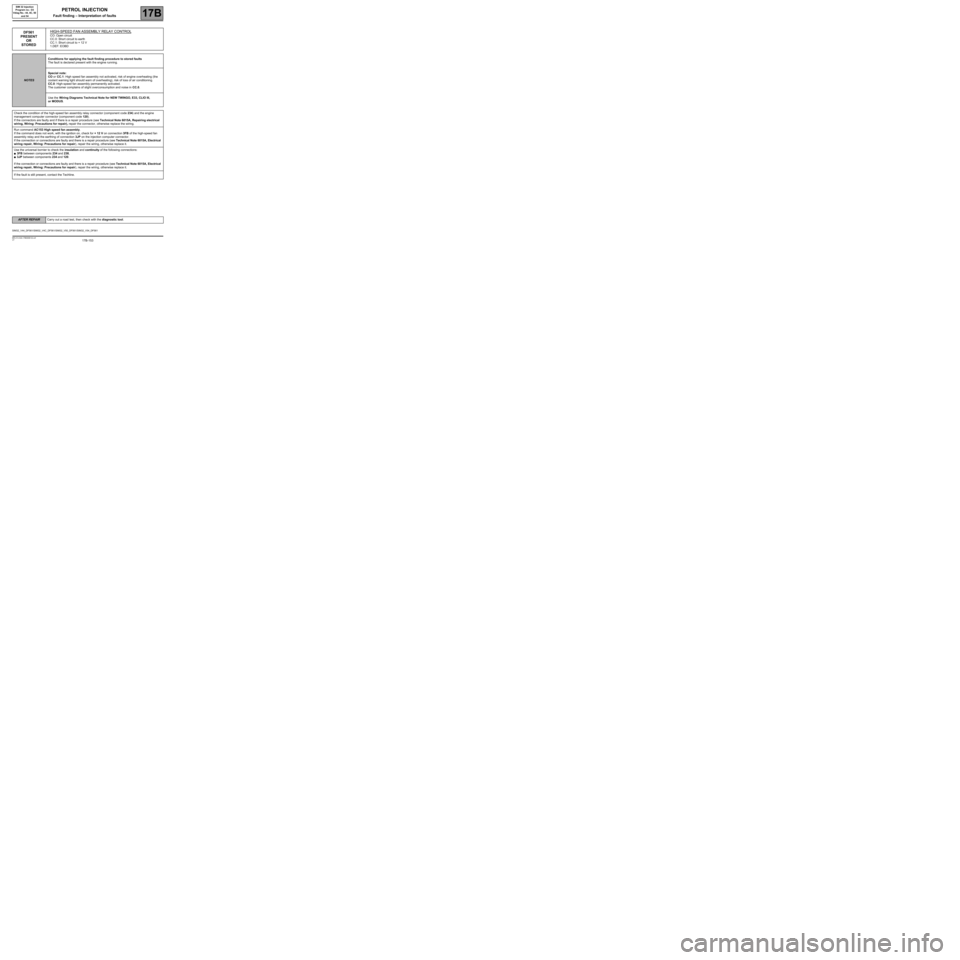
17B-153V7 MR-413-X44-17B000$133.mif
PETROL INJECTION
Fault finding – Interpretation of faults17B
SIM 32 Injection
Program no.: D3
Vdiag No.: 44, 4C, 50
and 54
DF561
PRESENT
OR
STOREDHIGH-SPEED FAN ASSEMBLY RELAY CONTROLCO: Open circuit
CC.0: Short circuit to earth
CC.1: Short circuit to + 12 V
1.DEF: EOBD
NOTESConditions for applying the fault finding procedure to stored faults
The fault is declared present with the engine running.
Special note:
CO or CC.1: High speed fan assembly not activated, risk of engine overheating (the
coolant warning light should warn of overheating), risk of loss of air conditioning.
CC.0: High-speed fan assembly permanently activated.
The customer complains of slight overconsumption and noise in CC.0.
Use the Wiring Diagrams Technical Note for NEW TWINGO, E33, CLIO III,
or MODUS.
Check the condition of the high-speed fan assembly relay connector (component code 234) and the engine
management computer connector (component code 120).
If the connectors are faulty and if there is a repair procedure (see Technical Note 6015A, Repairing electrical
wiring, Wiring: Precautions for repair), repair the connector, otherwise replace the wiring.
Run command AC153 High speed fan assembly.
If the command does not work, with the ignition on, check for + 12 V on connection 3FB of the high-speed fan
assembly relay and the earthing of connection 3JP on the injection computer connector.
If the connection or connections are faulty and there is a repair procedure (see Technical Note 6015A, Electrical
wiring repair, Wiring: Precautions for repair), repair the wiring, otherwise replace it.
Use the universal bornier to check the insulation and continuity of the following connections:
●3FB between components 234 and 238,
●3JP between components 234 and 120.
If the connection or connections are faulty and there is a repair procedure (see Technical Note 6015A, Electrical
wiring repair, Wiring: Precautions for repair), repair the wiring, otherwise replace it.
If the fault is still present, contact the Techline.
SIM32_V44_DF561/SIM32_V4C_DF561/SIM32_V50_DF561/SIM32_V54_DF561
AFTER REPAIRCarry out a road test, then check with the diagnostic tool.
Page 154 of 348
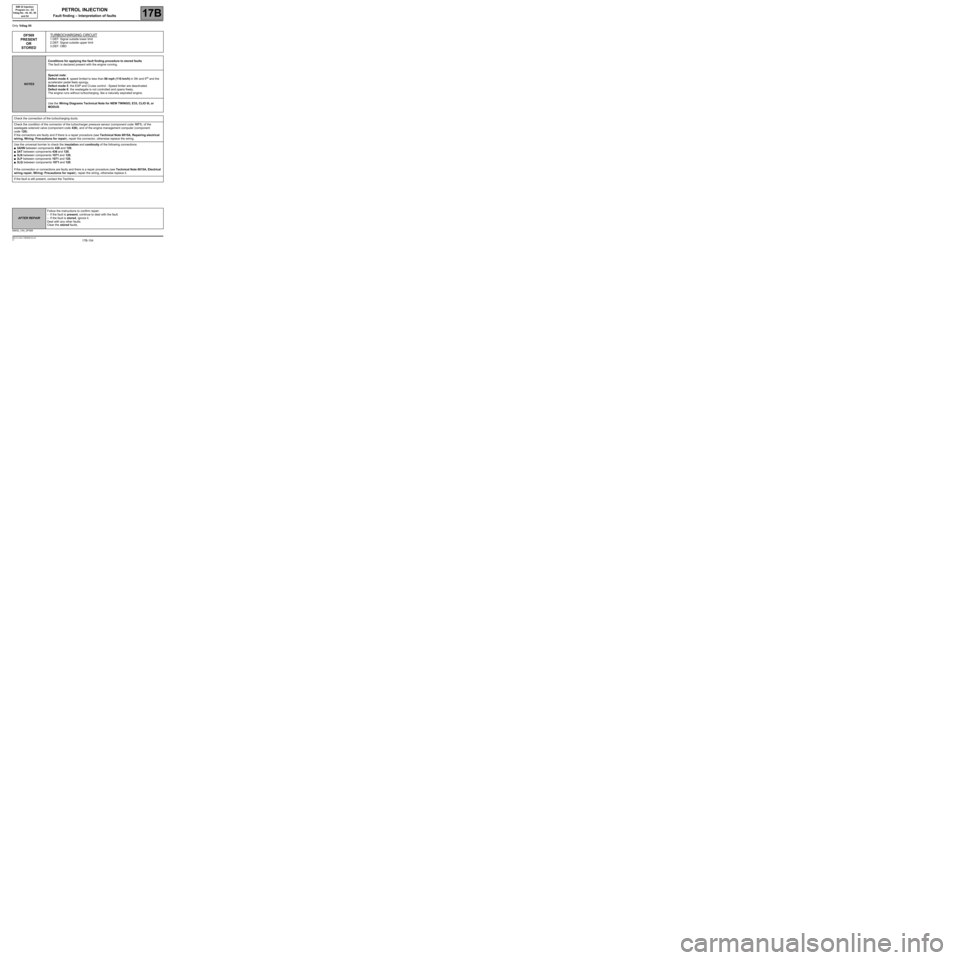
17B-154V7 MR-413-X44-17B000$133.mif
PETROL INJECTION
Fault finding – Interpretation of faults17B
SIM 32 Injection
Program no.: D3
Vdiag No.: 44, 4C, 50
and 54
Only Vdiag 54
DF569
PRESENT
OR
STOREDTURBOCHARGING CIRCUIT
1.DEF: Signal outside lower limit
2.DEF: Signal outside upper limit
3.DEF: OBD
NOTESConditions for applying the fault finding procedure to stored faults
The fault is declared present with the engine running.
Special note:
Defect mode 4: speed limited to less than 66 mph (110 km/h) in 5th and 6
th and the
accelerator pedal feels spongy.
Defect mode 5: the ESP and Cruise control - Speed limiter are deactivated.
Defect mode 6: the wastegate is not controlled and opens freely.
The engine runs without turbocharging, like a naturally aspirated engine.
Use the Wiring Diagrams Technical Note for NEW TWINGO, E33, CLIO III, or
MODUS.
Check the connection of the turbocharging ducts.
Check the condition of the connector of the turbocharger pressure sensor (component code 1071), of the
wastegate solenoid valve (component code 436), and of the engine management computer (component
code 120).
If the connectors are faulty and if there is a repair procedure (see Technical Note 6015A, Repairing electrical
wiring, Wiring: Precautions for repair), repair the connector, otherwise replace the wiring.
Use the universal bornier to check the insulation and continuity of the following connections:
●3AHN between components 436 and 120,
●3AT between components 436 and 120,
●3LN between components 1071 and 120,
●3LP between components 1071 and 120,
●3LQ between components 1071 and 120.
If the connection or connections are faulty and there is a repair procedure (see Technical Note 6015A, Electrical
wiring repair, Wiring: Precautions for repair), repair the wiring, otherwise replace it.
If the fault is still present, contact the Techline.
SIM32_V54_DF569
AFTER REPAIRFollow the instructions to confirm repair:
–If the fault is present, continue to deal with the fault.
–If the fault is stored, ignore it.
Deal with any other faults.
Clear the stored faults.
Page 155 of 348

17B-155V7 MR-413-X44-17B000$133.mif
PETROL INJECTION
Fault finding – Interpretation of faults17B
SIM 32 Injection
Program no.: D3
Vdiag No.: 44, 4C, 50
and 54
DF603
PRESENT
OR
STOREDUCH MULTIPLEX CONNECTION
1.DEF: Multiplex line connection fault
NOTESConditions for applying the fault finding procedure to stored faults:
The fault is declared present when the ignition is switched on.
Special notes:
When this fault is present, the air conditioning request is not recognised.
Run a multiplex network test (see 88B, Multiplex).
If the fault is not resolved, run fault finding on the UCH system (see 87B, Passenger compartment connection
unit)
SIM32_V44_DF603 / SIM32_V4C_DF603 / SIM32_V50_DF603 / SIM32_V54_DF603
AFTER REPAIRFollow the instructions to confirm repair:
–If the fault is present, continue to deal with the fault.
–If the fault is stored, ignore it.
Deal with any other faults.
Clear the stored faults.
Page 156 of 348
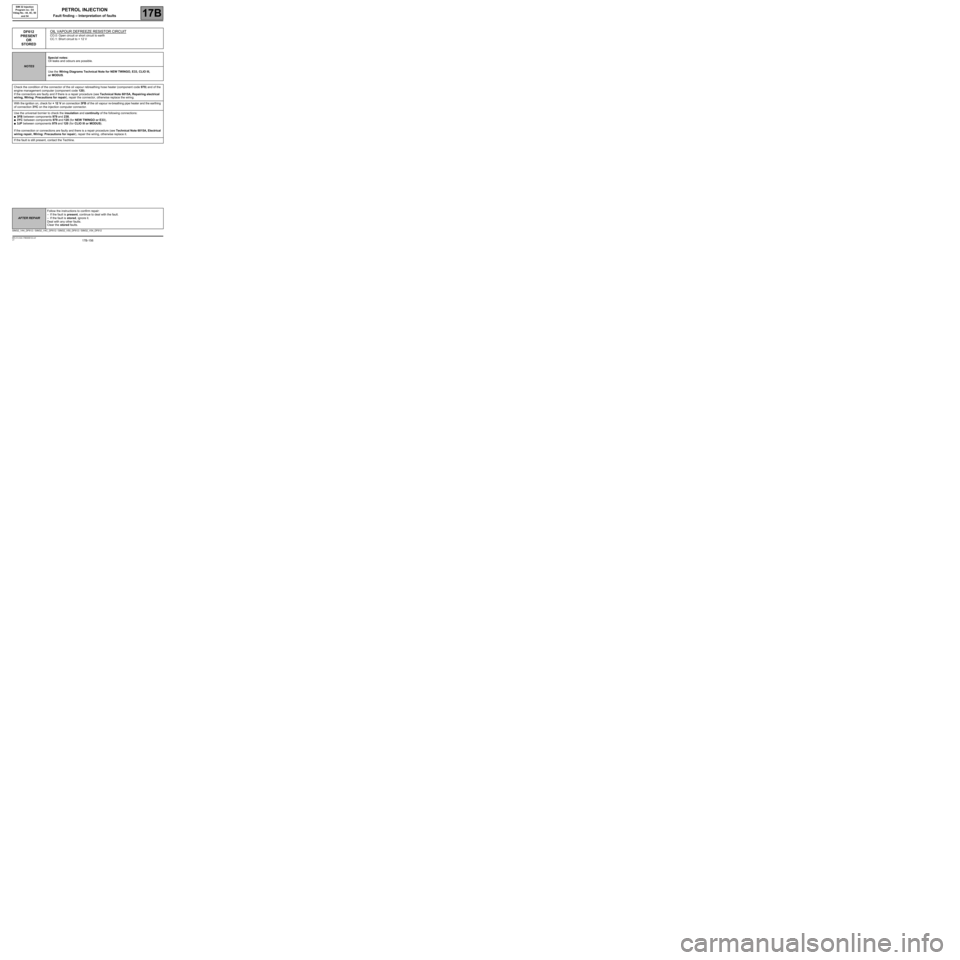
17B-156V7 MR-413-X44-17B000$133.mif
PETROL INJECTION
Fault finding – Interpretation of faults17B
SIM 32 Injection
Program no.: D3
Vdiag No.: 44, 4C, 50
and 54
DF612
PRESENT
OR
STOREDOIL VAPOUR DEFREEZE RESISTOR CIRCUIT
CO.0: Open circuit or short circuit to earth
CC.1: Short circuit to + 12 V
NOTESSpecial notes:
Oil leaks and odours are possible.
Use the Wiring Diagrams Technical Note for NEW TWINGO, E33, CLIO III,
or MODUS.
Check the condition of the connector of the oil vapour rebreathing hose heater (component code 979) and of the
engine management computer (component code 120).
If the connectors are faulty and if there is a repair procedure (see Technical Note 6015A, Repairing electrical
wiring, Wiring: Precautions for repair), repair the connector, otherwise replace the wiring.
With the ignition on, check for + 12 V on connection 3FB of the oil vapour re-breathing pipe heater and the earthing
of connection 3YC on the injection computer connector.
Use the universal bornier to check the insulation and continuity of the following connections:
●3FB between components 979 and 238,
●3YC between components 979 and 120 (for NEW TWINGO or E33),
●3JP between components 979 and 120 (for CLIO III or MODUS).
If the connection or connections are faulty and there is a repair procedure (see Technical Note 6015A, Electrical
wiring repair, Wiring: Precautions for repair), repair the wiring, otherwise replace it.
If the fault is still present, contact the Techline.
SIM32_V44_DF612 / SIM32_V4C_DF612 / SIM32_V50_DF612 / SIM32_V54_DF612
AFTER REPAIRFollow the instructions to confirm repair:
–If the fault is present, continue to deal with the fault.
–If the fault is stored, ignore it.
Deal with any other faults.
Clear the stored faults.
Page 157 of 348
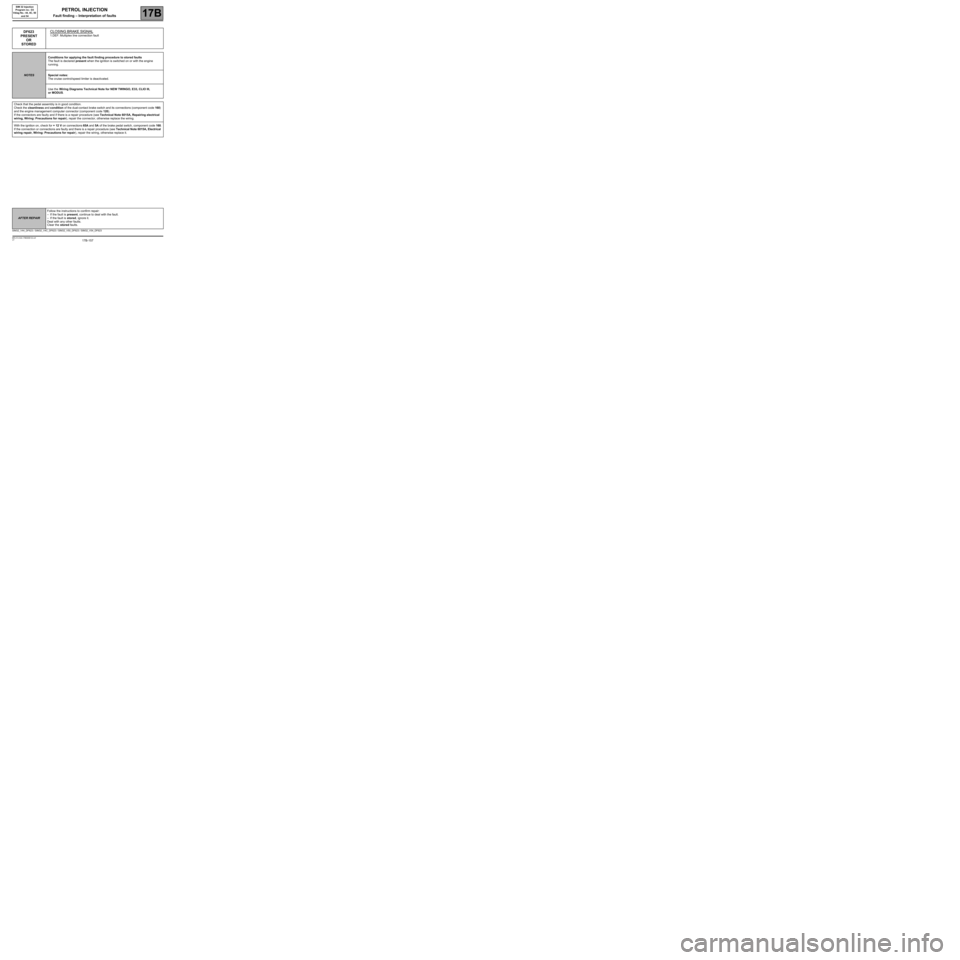
17B-157V7 MR-413-X44-17B000$133.mif
PETROL INJECTION
Fault finding – Interpretation of faults17B
SIM 32 Injection
Program no.: D3
Vdiag No.: 44, 4C, 50
and 54
DF623
PRESENT
OR
STOREDCLOSING BRAKE SIGNAL
1.DEF: Multiplex line connection fault
NOTESConditions for applying the fault finding procedure to stored faults
The fault is declared present when the ignition is switched on or with the engine
running.
Special notes:
The cruise control/speed limiter is deactivated.
Use the Wiring Diagrams Technical Note for NEW TWINGO, E33, CLIO III,
or MODUS.
Check that the pedal assembly is in good condition.
Check the cleanliness and condition of the dual-contact brake switch and its connections (component code 160)
and the engine management computer connector (component code 120).
If the connectors are faulty and if there is a repair procedure (see Technical Note 6015A, Repairing electrical
wiring, Wiring: Precautions for repair), repair the connector, otherwise replace the wiring.
With the ignition on, check for + 12 V on connections 65A and 5A of the brake pedal switch, component code 160.
If the connection or connections are faulty and there is a repair procedure (see Technical Note 6015A, Electrical
wiring repair, Wiring: Precautions for repair), repair the wiring, otherwise replace it.
SIM32_V44_DF623 / SIM32_V4C_DF623 / SIM32_V50_DF623 / SIM32_V54_DF623
AFTER REPAIRFollow the instructions to confirm repair:
–If the fault is present, continue to deal with the fault.
–If the fault is stored, ignore it.
Deal with any other faults.
Clear the stored faults.
Page 158 of 348
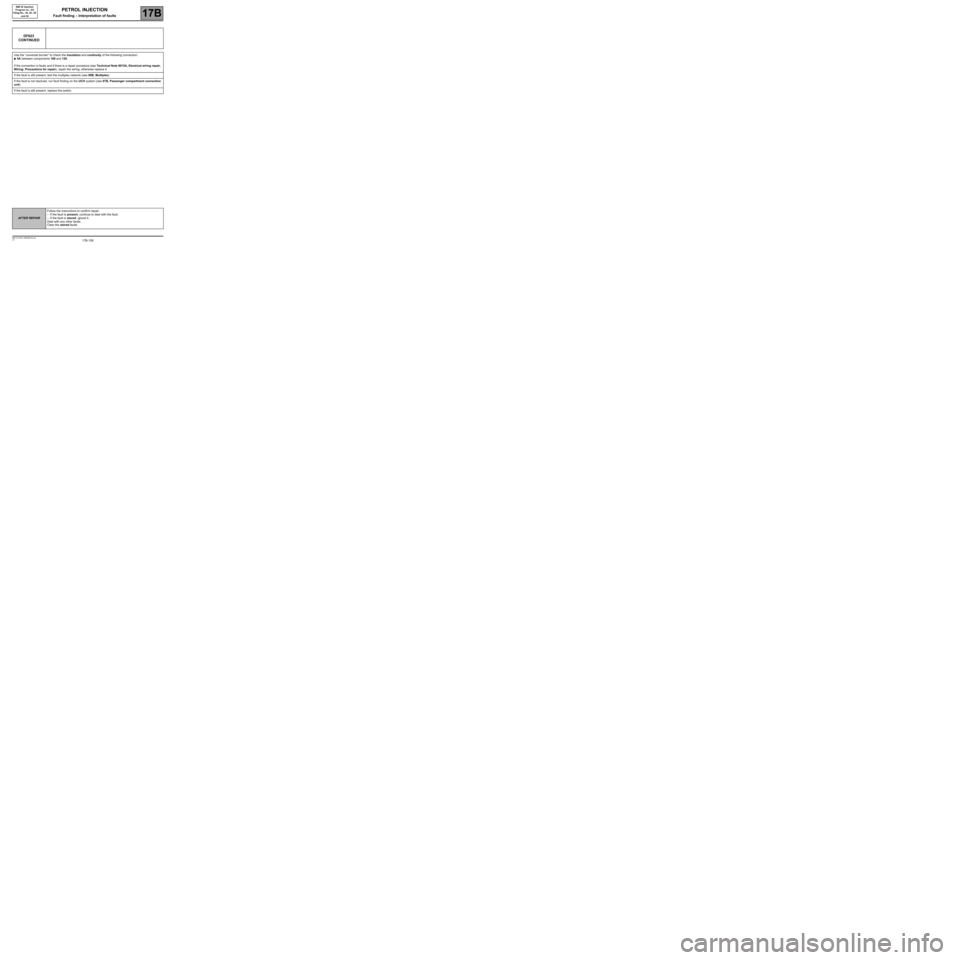
17B-158V7 MR-413-X44-17B000$133.mif
PETROL INJECTION
Fault finding – Interpretation of faults17B
SIM 32 Injection
Program no.: D3
Vdiag No.: 44, 4C, 50
and 54
DF623
CONTINUED
Use the "universal bornier" to check the insulation and continuity of the following connection:
●5A between components 160 and 120,
If the connection is faulty and if there is a repair procedure (see Technical Note 6015A, Electrical wiring repair,
Wiring: Precautions for repair), repair the wiring, otherwise replace it.
If the fault is still present, test the multiplex network (see 88B, Multiplex).
If the fault is not resolved, run fault finding on the UCH system (see 87B, Passenger compartment connection
unit)
If the fault is still present, replace the switch.
AFTER REPAIRFollow the instructions to confirm repair:
–If the fault is present, continue to deal with the fault.
–If the fault is stored, ignore it.
Deal with any other faults.
Clear the stored faults.
Page 159 of 348
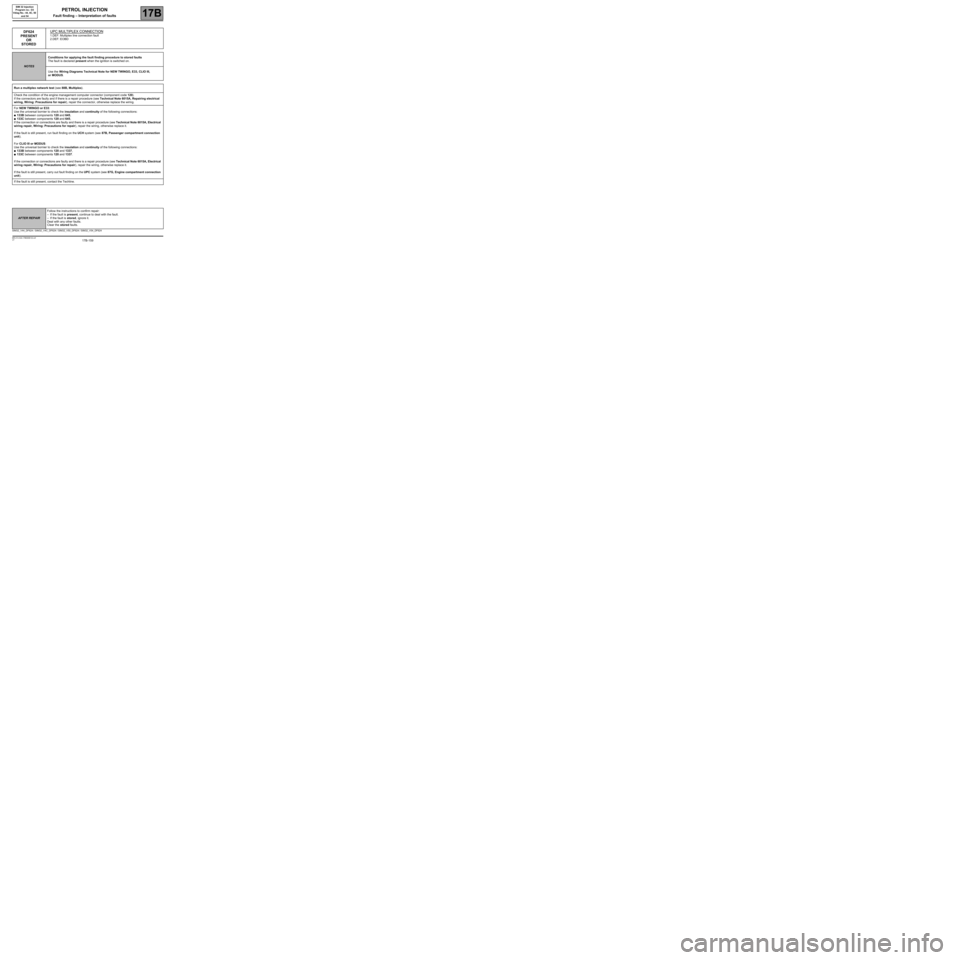
17B-159V7 MR-413-X44-17B000$133.mif
PETROL INJECTION
Fault finding – Interpretation of faults17B
SIM 32 Injection
Program no.: D3
Vdiag No.: 44, 4C, 50
and 54
DF624
PRESENT
OR
STOREDUPC MULTIPLEX CONNECTION
1.DEF: Multiplex line connection fault
2.DEF: EOBD
NOTESConditions for applying the fault finding procedure to stored faults
The fault is declared present when the ignition is switched on.
Use the Wiring Diagrams Technical Note for NEW TWINGO, E33, CLIO III,
or MODUS.
Run a multiplex network test (see 88B, Multiplex).
Check the condition of the engine management computer connector (component code 120).
If the connectors are faulty and if there is a repair procedure (see Technical Note 6015A, Repairing electrical
wiring, Wiring: Precautions for repair), repair the connector, otherwise replace the wiring.
For NEW TWINGO or E33:
Use the universal bornier to check the insulation and continuity of the following connections:
●133B between components 120 and 645,
●133C between components 120 and 645,
If the connection or connections are faulty and there is a repair procedure (see Technical Note 6015A, Electrical
wiring repair, Wiring: Precautions for repair), repair the wiring, otherwise replace it.
If the fault is still present, run fault finding on the UCH system (see 87B, Passenger compartment connection
unit).
For CLIO III or MODUS:
Use the universal bornier to check the insulation and continuity of the following connections:
●133B between components 120 and 1337,
●133C between components 120 and 1337.
If the connection or connections are faulty and there is a repair procedure (see Technical Note 6015A, Electrical
wiring repair, Wiring: Precautions for repair), repair the wiring, otherwise replace it.
If the fault is still present, carry out fault finding on the UPC system (see 87G, Engine compartment connection
unit).
If the fault is still present, contact the Techline.
SIM32_V44_DF624 / SIM32_V4C_DF624 / SIM32_V50_DF624 / SIM32_V54_DF624
AFTER REPAIRFollow the instructions to confirm repair:
–If the fault is present, continue to deal with the fault.
–If the fault is stored, ignore it.
Deal with any other faults.
Clear the stored faults.
Page 160 of 348
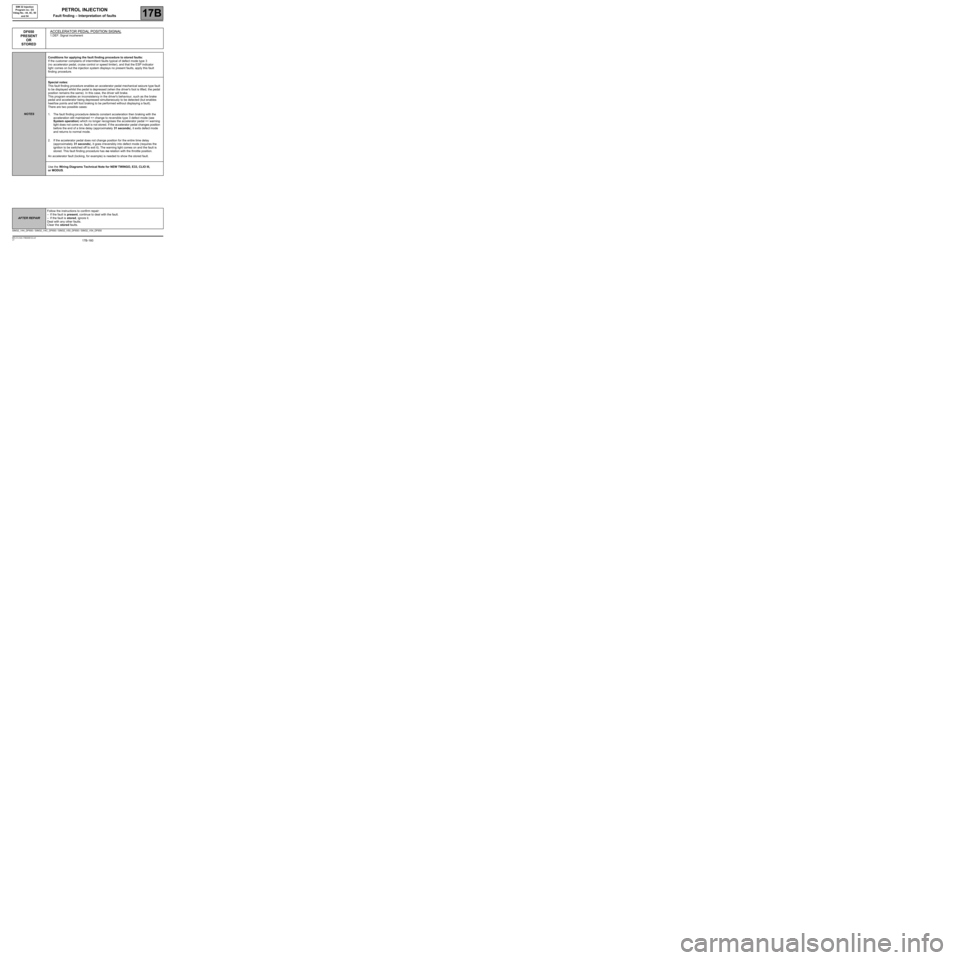
17B-160V7 MR-413-X44-17B000$133.mif
PETROL INJECTION
Fault finding – Interpretation of faults17B
SIM 32 Injection
Program no.: D3
Vdiag No.: 44, 4C, 50
and 54
DF650
PRESENT
OR
STOREDACCELERATOR PEDAL POSITION SIGNAL
1.DEF: Signal incoherent
NOTESConditions for applying the fault finding procedure to stored faults:
If the customer complains of intermittent faults typical of defect mode type 3
(no accelerator pedal, cruise control or speed limiter), and that the ESP indicator
light comes on but the injection system displays no present faults, apply this fault
finding procedure.
Special notes:
This fault finding procedure enables an accelerator pedal mechanical seizure type fault
to be displayed whilst the pedal is depressed (when the driver's foot is lifted, the pedal
position remains the same). In this case, the driver will brake.
This program enables an inconsistency in the driver's behaviour, such as the brake
pedal and accelerator being depressed simultaneously to be detected (but enables
heel/toe points and left foot braking to be performed without displaying a fault).
There are two possible cases:
1. The fault finding procedure detects constant acceleration then braking with the
acceleration still maintained => change to reversible type 3 defect mode (see
System operation) which no longer recognises the accelerator pedal => warning
light does not come on, fault is not stored. If the accelerator pedal changes position
before the end of a time delay (approximately 31 seconds), it exits defect mode
and returns to normal mode.
2. If the accelerator pedal does not change position for the entire time delay
(approximately 31 seconds), it goes irreversibly into defect mode (requires the
ignition to be switched off to exit it). The warning light comes on and the fault is
stored. This fault finding procedure has no relation with the throttle position.
An accelerator fault (locking, for example) is needed to show the stored fault.
Use the Wiring Diagrams Technical Note for NEW TWINGO, E33, CLIO III,
or MODUS.
SIM32_V44_DF650 / SIM32_V4C_DF650 / SIM32_V50_DF650 / SIM32_V54_DF650
AFTER REPAIRFollow the instructions to confirm repair:
–If the fault is present, continue to deal with the fault.
–If the fault is stored, ignore it.
Deal with any other faults.
Clear the stored faults.